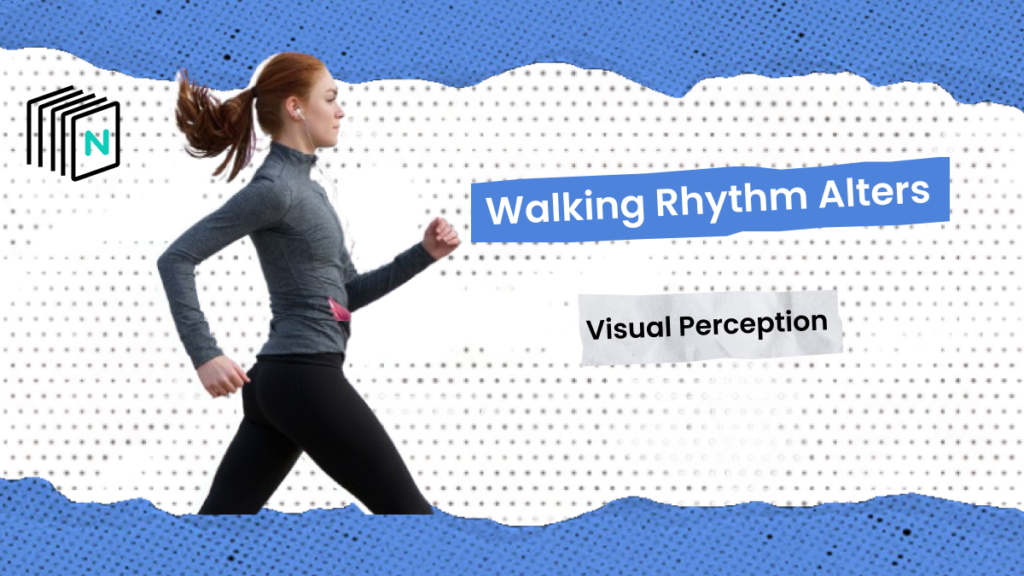Connection Between Walking and Vision

Have you ever paused to consider the intricate dance between your steps and the way you perceive the world around you?
In a groundbreaking study recently published in Nature Communications, Dr. Matthew Davidson and his team from the University of Sydney unveiled a captivating connection between the rhythm of our steps and the fluctuations in our visual perception.
Their research, conducted with meticulous precision and ingenuity, delves into the dynamic interplay between our locomotion and how we perceive the environment.
As you swing from one step to the next, your perception sharpens, and your reactions become faster. However, during footfalls, your vision isn’t as keen, leading to slower responses. This study, utilizing virtual reality and motion tracking technologies, challenges our previous notions of constant visual perception. Instead, it suggests that our brains sample the world in a strobe-like rhythm that aligns with our walking pace.
However, as your foot makes contact with the ground, entering the footfall phase, your vision seems to momentarily dull, and your responses slow down—a curious phenomenon indeed.
Utilizing cutting-edge virtual reality technology and precise motion tracking methods, the researchers unveiled a reality that challenges our conventional understanding of constant visual perception.
Rather than perceiving the world as a continuous stream of information, their findings suggest that our brains sample visual stimuli in a rhythmic, almost pulsating manner that synchronizes with our walking pace.
Dr. Davidson, the lead author of the study, eloquently describes their findings as “a previously unknown relationship between perception and movement,” underscoring how their work bridges the gap between experimental psychology and our everyday experiences.
Their study sheds light on the rhythmic nature of our brain’s processing of visual information, revealing how our sensitivity to visual stimuli fluctuates in harmony with the rhythm of our steps.
Professor David Alais, another prominent figure in the research, emphasizes the significance of these discoveries, particularly noting how these oscillations in our brain’s sampling of the world slow down during walking to align with the step cycle—a revelation that could revolutionize our understanding of human behavior and decision-making processes.
Indeed, the implications of this research are far-reaching. It paves the way for the development of diagnostic tools for neurological disorders and psychiatric illnesses, offering new avenues for early detection and intervention.
Furthermore, it opens doors for optimizing athletic performance by enhancing decision-making and reaction times in athletes—a prospect that could reshape training regimens and performance strategies across various sports disciplines.
But what lies at the heart of this intricate connection between our perception and movement?
Professor Alais proposes a compelling theory, suggesting that while our foot is grounded, vision takes a backseat to motor control as we plan our next step.
Yet, as we transition into the swing phase between footfalls, our brain swiftly shifts its focus back to perceptual sampling, creating a seamless rhythm that mirrors our step rate.
Moreover, this study ignites curiosity about how other sensory inputs, such as sound and touch, might modulate as we walk—a question that promises to unveil even more layers of complexity in our understanding of human perception.
As the research team embarks on further explorations, they aim to uncover the full extent of the implications of their findings.
Their quest to unravel the mysteries of perception not only promises to deepen our understanding of the fundamental nature of human cognition but also holds the potential to revolutionize how we interact with and interpret the world around us.
In conclusion, the journey into the rhythms of perception undertaken by Dr. Davidson and his team marks a significant leap forward in our quest for knowledge.
By shedding light on the intricate relationship between movement and vision, their research offers a captivating glimpse into the inner workings of the human mind.
As we continue to peel back the layers of complexity, we unearth new possibilities for enhancing our perception and enriching our experiences in the world we inhabit.
Stay tuned for more mind-blowing discoveries from Neureads.com – your go-to destination for simplified neurotech news, stories, and explanations.
